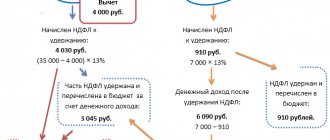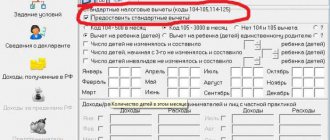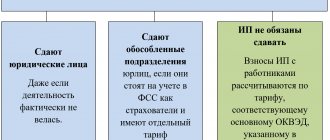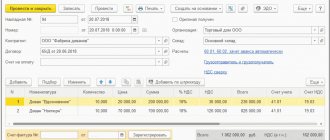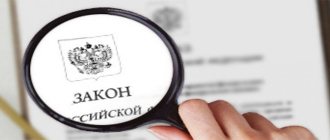VAT is an indirect federal tax, the calculation of which is carried out by the seller when selling goods to the buyer, i.e. In addition to the price of the goods sold, the buyer is required to pay VAT calculated at a certain tax rate. This tax is subject to mandatory declaration. In 2022, the declaration is provided only in electronic form.
VAT returns are submitted quarterly by the 25th day of the month following the reporting quarter. The VAT return is verified by the Federal Tax Service, including the indication of transaction type codes (KVO) reflected in the declaration (section 7), purchase and sales books.
One of the errors in the declaration is incorrect codes. Let's look at what quotas need to be specified for different types of operations.
Reflection of transaction type codes
In VAT declarations, starting with reporting for the 3rd quarter of 2016, an updated list of VAT transaction codes is used; in the updated declarations for earlier periods, this list was not in effect.
QUOs apply to documents used for VAT calculations:
- shopping book
- sales book
- invoice journals
If an incorrect code is discovered when checking VAT reporting, the Federal Tax Service will send a request for explanations.
Important! The procedure for registering invoices, regardless of the change in the quotas, has not changed.
The Federal Tax Service has identified errors in every second VAT return. How not to get on this list?
In the reporting for the first quarter of 2022, errors were identified in almost every second VAT return
. This was reported by specialists from the Federal Tax Service for the Amur Region on the departmental website. 1C services and programs help users avoid mistakes and provide timely explanations to tax authorities.
Federal Tax Service specialists complained about a significant number of discrepancies when comparing information from the VAT return
counterparties and listed
six main mistakes
that payers make when preparing VAT reports.
- Incorrect reflection of code 26 of the transaction type “Issuing invoices to persons who are not VAT payers” in section 9 (“ sales book
”) of the VAT declaration. Taxpayers, when selling goods to their customers with VAT, reflect code 26 instead of the required code 01 “Shipment or purchase of goods (work, services).” - Incorrect reflection of transaction type codes, details, and the seller’s INN when reflecting customs declarations. The import of goods into the territory of Russia must be reflected with code 20 of the type of operation, while carefully filling out the details of the customs declaration number (21-23 characters separated by a slash without spaces). The fields with the date, tax identification number and checkpoint of the seller remain empty, since the seller will be a foreign person and not the customs authority.
- Incorrect indication of the type of transaction code and TIN of the counterparty when reflecting advance payments. The seller, receiving an advance from the buyer, issues an invoice, reflecting it in his section 9 (“sales book”) of the tax return with code 02 of the type of transaction and the buyer’s TIN. When shipping goods, the seller in section 8 (“ purchase book
”) already indicates his TIN with code 22 of the type of transaction. - Discrepancies in control ratios. Most often, taxpayers make mistakes using codes 1.27 and 1.28. This means that the data reflected in section 3 of the tax return does not coincide with the data reflected in the purchase books and sales books.
- Discrepancies according to transaction type code 25. Thus, transaction type code 25 is used when registering invoices in the purchase book in relation to VAT amounts previously restored when performing transactions taxed at a rate of 0%, as well as a number of other cases. For example, if a company purchased a product and reflected this transaction in the purchase book, and then sold it abroad. Then in the sales book the details of the invoice
, which are reflected in the purchase book, with the cost in full and the amount of VAT in the part related to the sale transaction abroad.
After confirming the validity of applying a zero VAT rate,
such a transaction is reflected in the purchase book with transaction type code 25. The invoice must indicate its number and date (the same as those reflected in the sales book), the name and INN/KPP of the seller (that is, his own details), the full cost of the goods according to the invoice with VAT, the amount of VAT that calculated according to the sales book. When indicating in the purchase book an entry with transaction type code 25, the corresponding entry with transaction type code 21 is compared in the sales book. - A situation when the taxpayer-buyer accepts the amount of VAT for deduction, but the counterparty-seller does not calculate the corresponding amount of VAT on the sale. In this case, before concluding a transaction, the tax authorities recommend conducting a high-quality selection of counterparties, guided by the explanations of the Federal Tax Service, and also reconciling your data with the counterparty’s declaration before submitting reports.
The Federal Tax Service also reminds that for all types of errors, requirements for the provision of explanations are formed. For failure to provide explanations, the VAT payer faces a fine.
At the same time, tax authorities urge VAT payers to be more careful when filling out documents, correct errors in a timely manner and send the necessary explanations.
Let us remind you that requests for clarification from the Federal Tax Service go directly to the 1C:Enterprise 8 program, as indicated by the corresponding notification. To analyze the reasons for discrepancies, 1C has implemented a quick transition to the line of the declaration for which clarification is required. Using the program, you can analyze the situation and make clarifications in the documents. In this case, clarifying information will be generated automatically, and you can send it to the Federal Tax Service directly from 1C.
In addition, the 1C:Sverka service provides automatic reconciliation of invoices with suppliers and customers at any time - both during the accounting process and before sending a VAT return
to the tax authorities.
Errors in codes when reflected in the sales book
Errors in sales book codes occur:
- tax restoration - 21 must be indicated, except for the transfer of property to the authorized capital of another organization (01) or if an adjustment invoice for a decrease is issued (18)
- increase in cost - an adjustment invoice is provided, on the basis of which 01 is indicated (18 - for a decrease in cost)
- sales to the buyer on OSNO - put 01, because the seller can know exactly the mode used by the buyer (26 - for buyers on a special mode)
- all codes 01 to 26 are indicated, but only one is needed
- using a code not intended for the sales book, you must use the appropriate codes
VAT transaction codes in 2022 (table)
Let's list the transaction codes for the purchase book. In 2022, the list of codes from the appendix to the order of the Federal Tax Service of Russia dated March 14, 2016 No. ММВ-7-3/136 is in force. Codes are needed when a company records invoices in the purchase ledger. All codes in the table except 32 - it refers only to the special economic zone in the Kaliningrad region.
Select codes depending on which section of the declaration you are filling out and what specific operation you are having.
Codes for section 2, Appendix 1 to section. 3, section 4 – 7 declarations are given in Appendix No. 1 to the Procedure for filling out a VAT declaration. There are a lot of them. Choose the code exactly for your operation.
Codes for section 8 – 11 and Appendices to Section. Declarations 8 and 9 take the same ones that you had in the books of purchases and sales (additional sheets to them) and in the invoice journal.
Transaction type codes with decoding for the purchase book
| Situation | Designation |
| The buyer purchased goods, works or services. | 01 |
| The buyer purchased goods, works or services through a commission agent, an agent who acts on his own behalf (forwarder). | 01 |
| The seller received returned goods from the buyer on the common system, which he accepted for accounting. The buyer issued an invoice for these goods. | 01 |
| The seller received from the buyer on the general system the entire batch of returned goods, which he did not accept for accounting. The seller records his own invoice for the shipment of these goods in the purchase ledger. | 01 |
| The seller drew up a single adjustment invoice, in which he reduced the cost of shipments. | 01 |
| The buyer received an adjustment invoice or a single adjustment invoice in which the seller increased the cost of shipments. | 01 |
| The company claimed a deduction from the cost of construction and installation work for its own consumption. | 01 |
| The company received property from the participant as a contribution to the authorized capital. | 01 |
| The buyer made an advance payment to the seller. | 02 |
| The buyer made an advance payment through a commission agent or agent who purchases the goods on his own behalf. | 02 |
| The company claimed to deduct VAT, which it paid as a tax agent. | 06 |
| The company acquired the work of contractors for capital construction, modernization, and reconstruction of real estate. Or the company claims a deduction for materials, equipment, and contractors’ work based on the developer’s consolidated invoice. | 13 |
| The seller received returned goods from the buyer in special mode. If the buyer has returned part of the goods, the seller issues an adjustment invoice. If the buyer returned the entire shipment of goods, the seller claims a deduction based on the invoice that he previously prepared for the shipment. | 16 |
| The seller received returned goods from the individual buyer. | 17 |
| The seller issued an adjustment invoice to the buyer, in which he reduced the cost of the goods: - due to a decrease in price (tariff); - due to short delivery; - if the buyer on the general system returned some of the goods that were not accepted for registration. | 18 |
| The company imported goods from Belarus, Kazakhstan, Armenia or Kyrgyzstan (Eurasian Economic Union). | 19 |
| The company imported goods from countries that do not belong to the Eurasian Economic Union. | 20 |
| The seller declared a deduction of VAT, which he had previously charged on the advance payment: - on the date of shipment; - if you returned the advance to the buyer. | 22 |
| The company claimed a deduction for travel or entertainment expenses based on the BSO. | 23 |
| The exporter assessed tax on unconfirmed exports. Then he confirmed the 0 percent rate and claimed a deduction for the tax paid. | 24 |
| The company sold goods for export and restored the input tax on them. Then she confirmed the 0 percent rate and claimed a deduction. | 25 |
| On the date of shipment, the seller declared a deduction from advances received from buyers on a special regime or individuals. In the purchase book, the accountant registers an invoice or initial advance payment with summary data for the month or quarter. | 26 |
| The seller prepared an adjustment invoice or initial invoice for a reduction in tariffs for buyers on a special regime or individuals with summary data for a month or quarter. | 26 |
| The commission agent purchased goods, works or services from different sellers, received several invoices for one date and issued a consolidated invoice to the principal. The principal accepted VAT for deduction based on this invoice. |
Code 27 also indicates the principal who received the consolidated invoice of the agent acting on his own behalf.
VAT transaction codes with explanation for the sales book
| 27 | |
| The commission agent received several advance invoices from sellers for one date and issued a consolidated invoice for the advance payment to the principal. The principal claimed a deduction based on this invoice. | 28 |
| The number 28 is also indicated by the principal if he received a consolidated invoice for the advance from an agent who acts on his own behalf. |
| Situation | Designation |
| The seller shipped the goods, sold work or services. | 1 |
| The company transfers goods, performs work, and services for its own needs. | 1 |
| The company carries out construction and installation work for its own consumption. | 1 |
| The seller received amounts related to payment for goods, work or services. For example, interest or discount on bills transferred by the buyer, if they are higher than interest at the key rate. | 1 |
| The seller calculates the tax on the inter-price difference if: - he sold property that was included in VAT; — sold agricultural products and their processed products, which were previously purchased from individuals; — bought cars from individuals for resale, and then sold them. | 1 |
| The company restored the tax on the value of property that it transferred to the authorized capital of another organization. | 1 |
| The company sold goods for export. | 1 |
| The seller sold goods, works or services through a commission agent or agent who acts on his own behalf. | 1 |
| Using the common system, the buyer returned the goods accepted for registration to the seller. The buyer issued an invoice for the cost of goods | 1 |
| The buyer received a single adjustment invoice in which the seller reduced the cost of shipments. | 1 |
| The seller issued an adjustment invoice or a single adjustment invoice, in which he increased the cost of shipments. | 1 |
| The seller received an advance from the buyer. | 2 |
| The seller received the advance payment through a commission agent or agent who acts on his own behalf. | 2 |
| The company calculated VAT as a tax agent if it transferred payment: - when purchasing goods, works or services in the Russian Federation from a foreign seller; - for renting state or municipal property or when purchasing it. | 6 |
| The company, as an intermediary, purchased goods, works or services in the Russian Federation from a foreign counterparty and withheld VAT as a tax agent. | 6 |
| The company sells goods, works or services free of charge. | 10 |
| The contractor carries out capital construction, modernization or reconstruction of real estate. | 13 |
| The company transferred property rights under an assignment agreement. For example, if the supplier sold the buyer’s debt to pay for goods (clauses 1-4 of Article 155 of the Tax Code of the Russian Federation). | 14 |
| The commission agent issued one invoice to the buyer for the principal's goods and his own goods. In the sales book, the commission agent lists the tax only on the cost of his own goods. The number 15 is also given by an agent who acts on his own behalf if he has included his goods and the goods of the principal in the invoice. | 15 |
| The buyer received an adjustment invoice for the price (tariff) reduction. | 18 |
| The company restored the tax. For example, if the buyer received the goods and restored the VAT, which was previously deducted from the advance payment. There is no need to put the number 21 if the company: | 21 |
| - transferred property to the authorized capital - designated “01”; | |
| - received an adjustment invoice for a reduction in price (tariff) - denoted “18”. | |
| The seller sold goods, works, services to buyers on a special regime or to individuals. The accountant issued an invoice or primary report with summary data for the month or quarter. | 26 |
| The seller received an advance from buyers in special mode or individuals. The accountant issued an invoice or initial statement for the advance payment with summary data for the month or quarter. | 26 |
| The commission agent sold the goods of the principal, issued several invoices to customers on the same date and registered them in the accounting journal. The principal issued one consolidated invoice to the commission agent for these shipments. The number 27 is also used by the principal if he has issued a consolidated invoice to an agent who is acting on his own behalf. | 27 |
| The commission agent received advance payments from customers, issued several advance invoices on the same date and recorded them in the accounting journal. The principal issued one consolidated invoice to the commission agent for these advances. The number 28 is also used by the principal if he has issued a consolidated invoice for an advance to an agent who acts on his own behalf. | 28 |
| The company independently adjusts the tax base if the price of a transaction with an interdependent counterparty does not correspond to the market price (clause 6 of Article 105.3 of the Tax Code of the Russian Federation). | 29 |
What transaction codes can be entered in the sales (purchases) book and invoice journal
| Code | Book of purchases | Sales book | Part 1 of the invoice journal | Part 2 of the invoice journal |
| 1 | + | + | + | + |
| 2 | + | + | + | + |
| 6 | + | + | – | – |
| 10 | – | + | – | – |
| 13 | + | + | + | + |
| 14 | – | + | – | – |
| 15 | + | + | + | + |
| 16 | + | – | – | – |
| 17 | + | – | – | – |
| 18 | + | + | + | + |
| 19 | + | – | + | + |
| 20 | + | – | + | + |
| 21 | – | + | – | – |
| 22 | + | – | – | – |
| 23 | + | – | – | – |
| 24 | + | – | – | – |
| 25 | + | – | – | – |
| 26 | + | + | – | – |
| 27 | + | + | + | + |
| 28 | + | + | + | + |
| 29 | – | + | + | + |
| 30 | – | + | + | + |
| 31 | – | + | – | – |
| 32 | + | – | – | – |
Answers to common questions
Question No. 1 : An organization issued VAT invoices using the simplified tax system. Do I need to use VAT transaction codes and keep a sales ledger?
Answer : There is no need to use transaction codes. Organizations using the simplified tax system issue VAT invoices and fill out section 12 of the declaration, where codes are not provided, but only information from invoices, where codes are also not reflected. And there is no need to provide transaction codes on invoices. It is not the organization's responsibility to keep a sales book, because under the simplified tax system, organizations are not VAT payers and do not fill out section 9 in the declaration according to the sales book data.
